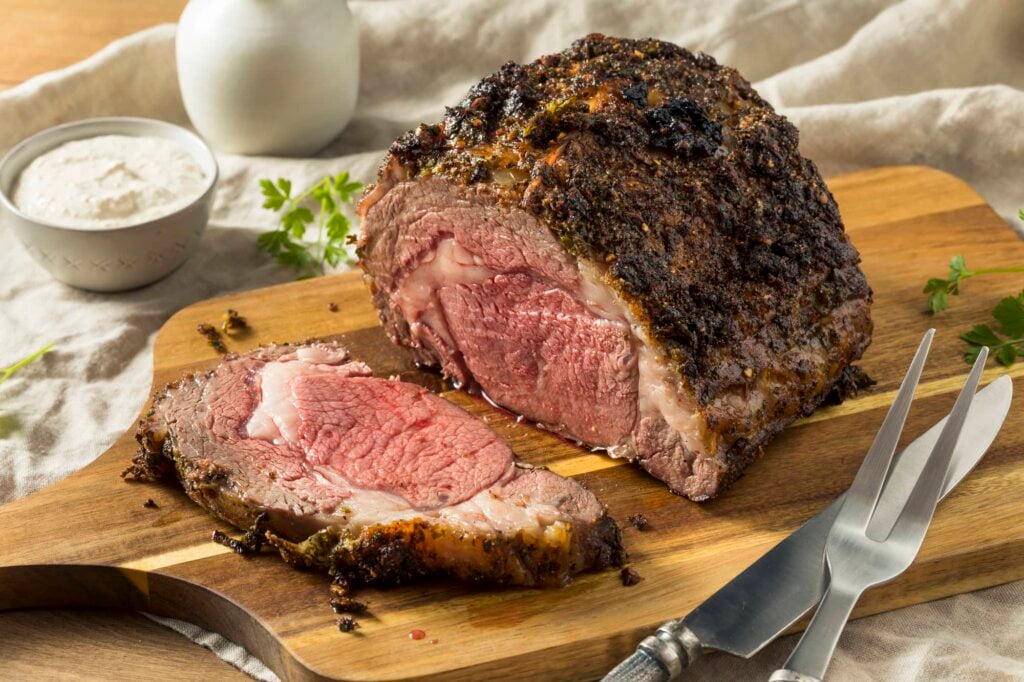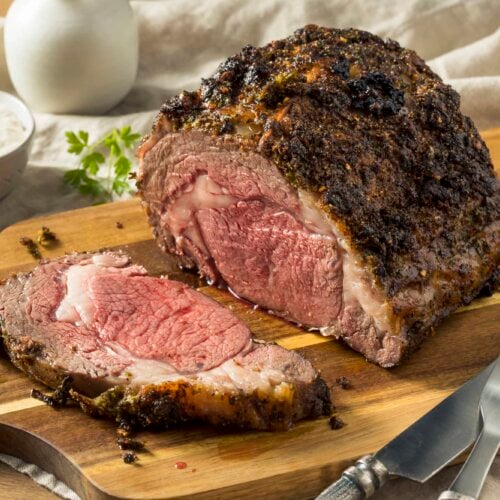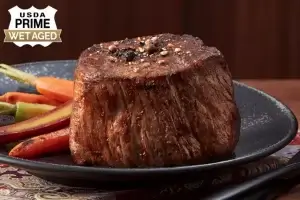
You’ve probably heard of cooking prime rib in the oven, on the grill, or in the smoker. These are all excellent ways to cook this decadent cut of beef. But if you haven’t yet tried rotisserie prime rib, you’re missing out on loads of flavor and juicy tenderness that really brings out the best of prime rib.
Don’t worry — we’ll cover all the details about how to make rotisserie prime rib so you can do it at home, including preparing and serving the prime rib.
Introduction to Rotisserie Cooking
Rotisserie cooking is a method of slow-roasting meat on a rotating spit over a steady heat source. It’s been used for centuries to achieve evenly cooked, tender meat with a crisp exterior that’s hard to replicate with other methods.
For prime rib, rotisserie cooking turns the meat constantly, allowing the prime rib to baste itself in its own rendered fat and juices. The result is a super moist interior and a caramelized exterior that develops throughout the rotisserie cooking process.
The consistent rotation also eliminates hot spots to create even cooking from edge to edge. And for a cut with substantial marbling like the prime rib, this even cooking is especially necessary. Rotisserie cooking helps the fat render down evenly, so every part of the prime rib benefits from its flavors and juices.
Once you master rotisserie cooking with prime rib, you’ll be able to transform an already impressive cut into something truly extraordinary with a tasty flavor profile you’ll want to enjoy again and again.
Preparation of Prime Rib for Rotisserie
Before you start cooking your prime rib rotisserie-style, spend some time preparing it. First, focus on trimming the prime rib. You’ll want to leave some of the fat cap in place to baste the meat as it rotates and cooks, but you can remove any excess fat, like large chunks of fat along the edges of the meat. Also, trim any loose pieces that might catch fire during the cooking process.
Then, truss the prime rib with butcher’s twine. Tie it snugly, leaving about one inch of space in between each section of twine. This helps the prime rib hold its shape while turning and cook evenly.
Next, season your prime rib. Use a generous coating of kosher salt along all sides of the prime rib. Apply salt 1-2 hours before cooking to brine the meat. Then, just before cooking, add freshly ground black pepper and your other chosen seasonings, like minced garlic and dried thyme. Some cooks like using a coffee-based rub or another spice rub to help form a crispy crust. It’s up to you — go with the seasonings you enjoy most, but don’t skip the salt and black pepper.
Rotisserie Prime Rib Cooking Process
Ready to start cooking? Fire up your rotisserie or grill to 325°F. Position the prime rib away from direct flames to avoid flare-ups from dripping fat and overcooking of the outside. For perfect medium-rare prime rib, plan on cooking for about 15 minutes per pound, although how long your prime rib takes ultimately depends on its thickness. Be sure to keep the lid over the rotisserie or grill while the meat cooks to hold in the heat.
Once the meat reaches an internal temperature of 120°F, lower the temperature to around 200°F. Continue cooking until the internal temperature hits 130°F for medium-rare. This slowed-down finish helps lock in the prime rib’s juices and bring it to the right internal temperature without overcooking the outside. Use a meat thermometer to check the prime rib’s temperature in its thickest part.
The meat will continue cooking slightly once you remove it from the rotisserie and let it rest for several minutes at room temperature.
Basting and Flavor Enhancements for Rotisserie Prime Rib
The self-basting nature of rotisserie cooking already gives prime rib an edge, but manual basting helps enhance its flavors and moisture even more. Reserve drippings from the meat in a drip pan and use them to baste the roast every 30-45 minutes while cooking. You can even add aromatics like onions, herbs, and wine in your drop pan to infuse more flavor into the prime rib.
Another option is wood chips or chunks to add smokiness to the rotisserie prime rib. Oak and hickory are excellent choices for beef that complement its flavors instead of overwhelming it. Or, use cherry or apple fr more sweetness. Soak wood chips for at least 30 minutes before cooking to slow down their burn.
Some people marinate prime rib to boost flavor, but it’s not a necessary step for this cut. Prime rib is already tender and highly flavorful on its own, so it usually does well getting the richness and depth that marinades bring on its own.
Rotisserie Prime Rib Recipe
Use the following recipe to create rotisserie prime rib like a pro.
Ingredients
- 5 to 10 lb prime rib roast (bone-in or boneless)
- 2 tbsp kosher salt
- 1 tbsp freshly ground black pepper
- 1 tbsp garlic, minced
- 1 tsp dried thyme
- Butcher’s twine
- Optional: spice rub, wine, herbs, onions for drip pan
Instructions
- Trim excess surface fat of the prime rib, leaving a thin layer for self-basting, and remove any loose pieces. Tie the roast every inch with butcher’s twine to help it keep its shape.
- Salt the roast liberally and let it sit at room temperature for 1–2 hours. Just before cooking, rub with black pepper, garlic, and thyme.
- Heat your rotisserie or grill to 325°F, and be sure to make an area for the meat to cook away from direct heat. Place a drip pan directly below where you’ll cook the meat.
- Mount the roast on the spit. Position it over the drip pan and away from direct flames. Cook for about 15 minutes per pound with the lid closed.
- Every 30–45 minutes, baste with pan drippings or a mix of wine, herbs, and aromatics if using.
- When the internal temp hits 120°F, lower the heat to 200°F and continue cooking to an internal temperature of 130°F for medium-rare. Remove from heat, tent loosely with foil, and rest for 20 minutes before slicing.
Serving Rotisserie Prime Rib
Like steaks and other meats, resting rotisserie prime rib after cooking is a necessary step to getting the results you expect. Allow your prime rib to rest for 20-30 minutes after coming off the rotisserie, which lets the meat’s juices redistribute throughout the roast for added tenderness and juiciness. When you’re ready to carve the prime rib, remove the twine first, then slice against the grain. Make slices about ½ an inch thick. Serve topped with a drizzle of reserved pan juices, if you’d like.
Conclusion: How to Make Rotisserie Prime Rib
When you nail rotisserie prime rib, you can truly turn heads at the dinner table. This slow-cooking method takes an already delicious cut and makes it even better with locked-in juices and a rich, deep, all-over flavor.Ready to try it for yourself? Order our bone-in heart of rib roast. You’ll get 8-9 pounds of quality rib roast sealed and wrapped with care to preserve freshness while it’s on its way to you.

Rotisserie Prime Rib
Ingredients
- 5 to 10 lb prime rib roast bone-in or boneless
- 2 tbsp kosher salt
- 1 tbsp freshly ground black pepper
- 1 tbsp garlic minced
- 1 tsp dried thyme
- Butcher’s twine
- Optional: spice rub wine, herbs, onions for drip pan
Instructions
- Trim excess surface fat of the prime rib, leaving a thin layer for self-basting, and remove any loose pieces. Tie the roast every inch with butcher’s twine to help it keep its shape.
- Salt the roast liberally and let it sit at room temperature for 1–2 hours. Just before cooking, rub with black pepper, garlic, and thyme.
- Heat your rotisserie or grill to 325°F, and be sure to make an area for the meat to cook away from direct heat. Place a drip pan directly below where you’ll cook the meat.
- Mount the roast on the spit. Position it over the drip pan and away from direct flames. Cook for about 15 minutes per pound with the lid closed.
- Every 30–45 minutes, baste with pan drippings or a mix of wine, herbs, and aromatics if using.
- When the internal temp hits 120°F, lower the heat to 200°F and continue cooking to an internal temperature of 130°F for medium-rare. Remove from heat, tent loosely with foil, and rest for 20 minutes before slicing.


